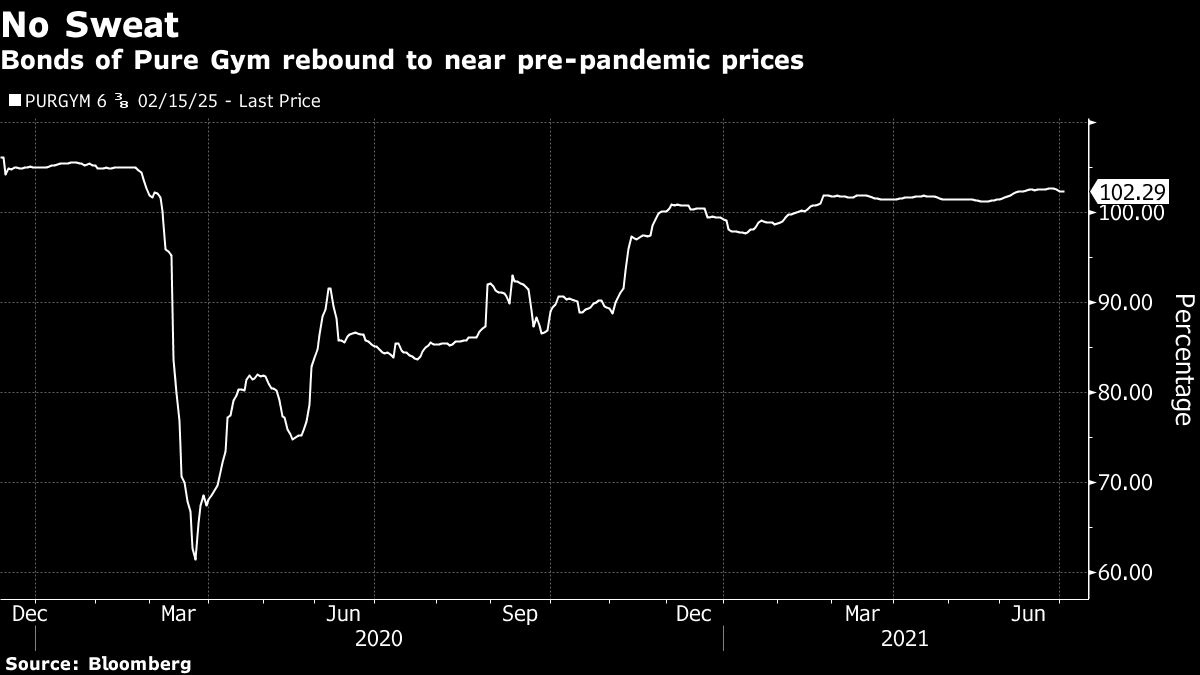Jul 8, 2021
Gyms are the unlikely winners of U.K. post-COVID reopening trade
, Bloomberg News
Can't depend on government bailouts to save you: Toronto gym owner
Packing sweaty, heavy-breathing strangers into enclosed spaces may seem like a disastrous business model for the post-pandemic era. But you wouldn’t know it from the love investors are showing shares and bonds of gyms in the U.K.
Gym Group Plc’s stock has jumped about 28 per cent this year, recouping almost all its losses from COVID-19 closures. In the bond market, investors have piled into high-yield debt offerings from the budget chain Pure Gym PLC and the more upmarket David Lloyd. While the gains are in line with the broader market recovery, gym operators are outperforming companies well placed to ride any economic rebound from the reopening.
As lockdowns ease, people are flooding back to their health clubs, while the newly fitness-conscious are signing up in droves, according to preliminary numbers from the U.K. gym industry. Pure Gym’s group membership is almost back to pre-pandemic levels, with its paying member base recovering to 91 per cent as of May 9. Health club operators in the U.K., Europe’s most high-profile gym companies in terms of investor attention, have become strong reopening plays.
“We’re not just seeing people return to the gym, but we’re seeing new members,” according to Harry Barnick, an analyst at Third Bridge, an independent research provider. “There’s the potential for gyms to actually do better than pre-COVID.”
While that may be the case, it’s apparent that the pandemic has shaken up the landscape. City-center chains, that did well in the pre-pandemic era, now face an uncertain future as many fearful commuters continue to work from home. Budget gyms with cheap, flexible membership and venues dotted across the suburbs, on the other hand, look set to prosper. The same holds for high-end health clubs offering pampering as well as perspiration.
No Frills
Take U.K. budget chain Pure Gym PLC, for instance. The no-frills operator -- with no swimming pools, minimal staff, leases on everything from buildings to equipment and venues in the suburbs -- has seen subscriber numbers soar. Just over half of its new members had never signed up at a gym before, according to the company’s first-quarter investor presentation. Members are coming to the gym more than they were pre-pandemic, with visits per subscriber per month 10 per cent-15 per cent higher than two years ago.
“Pure Gym is tapping into a real sweet spot at the moment,” said Mark Benbow, a high-yield fund manager at Aegon Asset. “People’s interest is being healthy, and yet needing flexibility. Being tied into expensive contracts isn’t appealing to most right now due to the uncertainty of the last year.” Pure Gym is one of the largest positions in Aegon’s maturity high-yield funds.
Pure Gym raised 445 million euros (US$525 million) through a bond sale in 2020 to finance its European expansion, while its private-equity owners provided a 100 million-pound (US$138 million) equity injection to bolster its balance sheet. Investors who bought the bonds in November at 95 cents on the euro are sitting pretty, thanks to the positive momentum around the U.K’s reopening; the bonds are now bid at 102.8 cents on the euro.

Even before the pandemic struck, value gyms offered investors an attractive growth story. The sector boomed in the wake of the financial crisis, growing by 121 per cent between 2008 and 2012, while the gym sector overall grew by 2.1 per cent, according to an OC&C consumer survey.
The pandemic has made them even more appealing, said Mark Watts, a high-yield credit analyst at Intesa Sanpaolo Spa.
“With some of the leisure and entertainment options limited or still closed, the younger demographic are expected to spend more on fitness,” he said.
Building Strength
David Lloyd has already capitalized on the built-up momentum of the U.K reopening trade and raised about 1 billion euros equivalent of debt in its first bond sale last month. Rating company Fitch assigned the new debt a B+ based on the recovery of memberships after sites reopened in the U.K, and increased attendance as clubs gradually reopen in Europe. The 645 million-pound tranche of the sale was bid at 99.9 pence on the pound on Thursday after pricing at par last month.
The fate of gym operators on the continent has been something of a mixed bag. While shares in Dutch chain Basic-Fit NV have rebounded sharply to surpass pre-pandemic levels, those of two Scandinavian companies -- Actic Group AB in Sweden and Sats AS in Norway -- have yet to fully bounce back.
Granted, even in the U.K., the shine may wear off a bit as the July 19 lifting of restrictions makes more activities available to people. Still, for the foreseeable future, location, pricing and flexibility will remain key, analysts said.
The city-center sites of Virgin Active, for example, have typically appealed to gym goers wanting to fit in a workout between leaving the office and going home. But the company suffered a hammer blow last year as the government’s work-from-home guidance turned city centers into ghost towns. Virgin Active buckled under the weight of heavy rents amid falling memberships and restructured in May.
“Many small-scale U.K. gyms are undergoing consolidation and rumors of a buyout swirl around London-centric gym Virgin Active,” said Third Bridge’s Barnick. “Investors are mulling which kinds of gyms are viable in the post-COVID world.” Virgin Active didn’t respond to a message seeking comment.
Meanwhile, amid worries about exercising in enclosed areas and the rise of virtual workouts and home gym equipment such as Peletons, after 15 months of lockdown measures, the industry’s medium-term prospects are promising, wrote RBC analyst Christine Zhou in an equities note to clients last month.
“With the focus on mental and physical health at the forefront, alongside the potential fallout from less well-capitalized operators in the near to medium term, the growth opportunities for well-financed leading players have only broadened,” she said.








